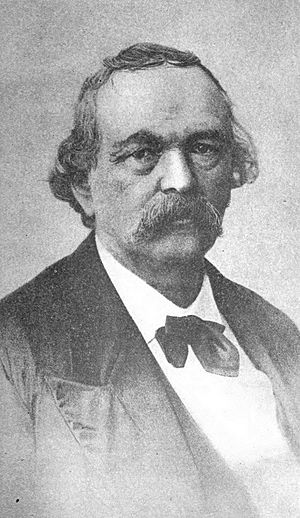Albert Taylor Bledsoe facts for kids
Quick facts for kids
Albert Taylor Bledsoe
|
|
|---|---|
 |
|
| Born | November 9, 1809 |
| Died | December 8, 1877 (aged 68) Alexandria, Virginia (another source says Baltimore, Maryland)
|
| Nationality | American |
| Alma mater | United States Military Academy Kenyon College, Ohio |
| Occupation | educator, attorney, author, and clergyman |
| Political party | Whig Party (United States) |
| Spouse(s) | Harriet Coxe (married in 1836) |
| Parent(s) | Moses Owsley Bledsoe and Sophia Childress Taylor |
Albert Taylor Bledsoe (November 9, 1809 – December 8, 1877) was an important American figure. He was an Episcopal priest, a lawyer, and a math professor. He also served as an officer in the Confederate army. Bledsoe is known for defending slavery before the American Civil War. After the war, he helped shape the "Lost Cause" idea. This idea tried to explain and defend the Southern side of the war. He wrote a book called Liberty and Slavery in 1856. It was a major work that argued for slavery as a way to keep society in order.
Contents
Early Life and Education
Albert Taylor Bledsoe was born on November 9, 1809. His birthplace was Frankfort, Kentucky. He was the oldest of five children. His parents were Moses Owsley Bledsoe and Sophia Childress Taylor. Sophia was related to President Zachary Taylor.
From 1825 to 1830, Bledsoe attended the United States Military Academy at West Point. He was a cadet there, just like Jefferson Davis and Robert E. Lee. After serving two years in the U.S. Army, he studied law and theology. He went to Kenyon College in Ohio for these studies. In 1836, he earned his M.A. and LL.M. degrees. That same year, he married Harriet Coxe. They had seven children together, but only four lived past childhood. His daughter, Sophia Bledsoe Herrick, became a writer.
College Professor and Mathematician
Bledsoe had a long career as a university professor. He mainly taught mathematics. Here are some of the places he taught:
- Adjunct Professor of Mathematics and French, Kenyon College (Ohio), 1833–1834.
- Professor of Mathematics, Miami University (Ohio), 1834–1835.
- Professor of Mathematics and Astronomy, University of Mississippi, 1848–1854.
- Professor of Mathematics, University of Virginia, 1854–1861.
While teaching math, Bledsoe often shared his political views. For example, he would talk about "States' rights" during his math lessons. He wrote a book called The Philosophy of Mathematics. This was one of the first American books on the subject. It included chapters about famous thinkers like René Descartes, Leibnitz, and Isaac Newton.
Bledsoe is also remembered for his book An Essay on Liberty and Slavery. In this book, he argued in favor of slavery. He believed that humans naturally live in society, not alone in nature. He thought that people in society needed rules and limits on their actions. He argued that true freedom meant having only the amount of freedom you were suited for. He believed some people needed to be controlled, while others deserved more freedom.
Clergyman
In 1835, Bledsoe became an Episcopal minister. He worked as an assistant to Bishop Smith in Kentucky. However, he stopped being a clergyman in 1838. This was because he disagreed with the practice of infant baptism.
Later in his life, in 1871, he became a Methodist minister. But he never took charge of a church. He strongly supported the idea of "free will." This means he believed people have the power to make their own choices. He wrote a book about his views called Examination of Edwards on the Will (1845).
Lawyer
In 1838, Bledsoe moved to Springfield, Illinois. There, he became a law partner with Edward Dickinson Baker. He practiced law in the same courts as famous figures like Abraham Lincoln and Stephen A. Douglas. From 1840 to 1848, he argued cases before the United States Supreme Court in Washington D.C.
Confederate Official
When the American Civil War began in 1861, Bledsoe joined the Confederate army. He was given the rank of colonel. Later, he became the Acting Assistant Secretary of War. In 1863, he was sent to London, England. His job there was to research historical issues related to the war. He also worked to gain support for the Confederate cause among the British public.
Southern Apologist
In 1868, after the Civil War ended, Bledsoe returned to the United States. He started publishing a magazine called the Southern Review. He was known as an "unreconstructed Southerner." This means he continued to strongly defend Southern viewpoints. He published articles that supported slavery and the idea of secession (states leaving the Union).
Death
Albert Taylor Bledsoe died on December 8, 1877. He passed away in Alexandria, Virginia.
See Also

